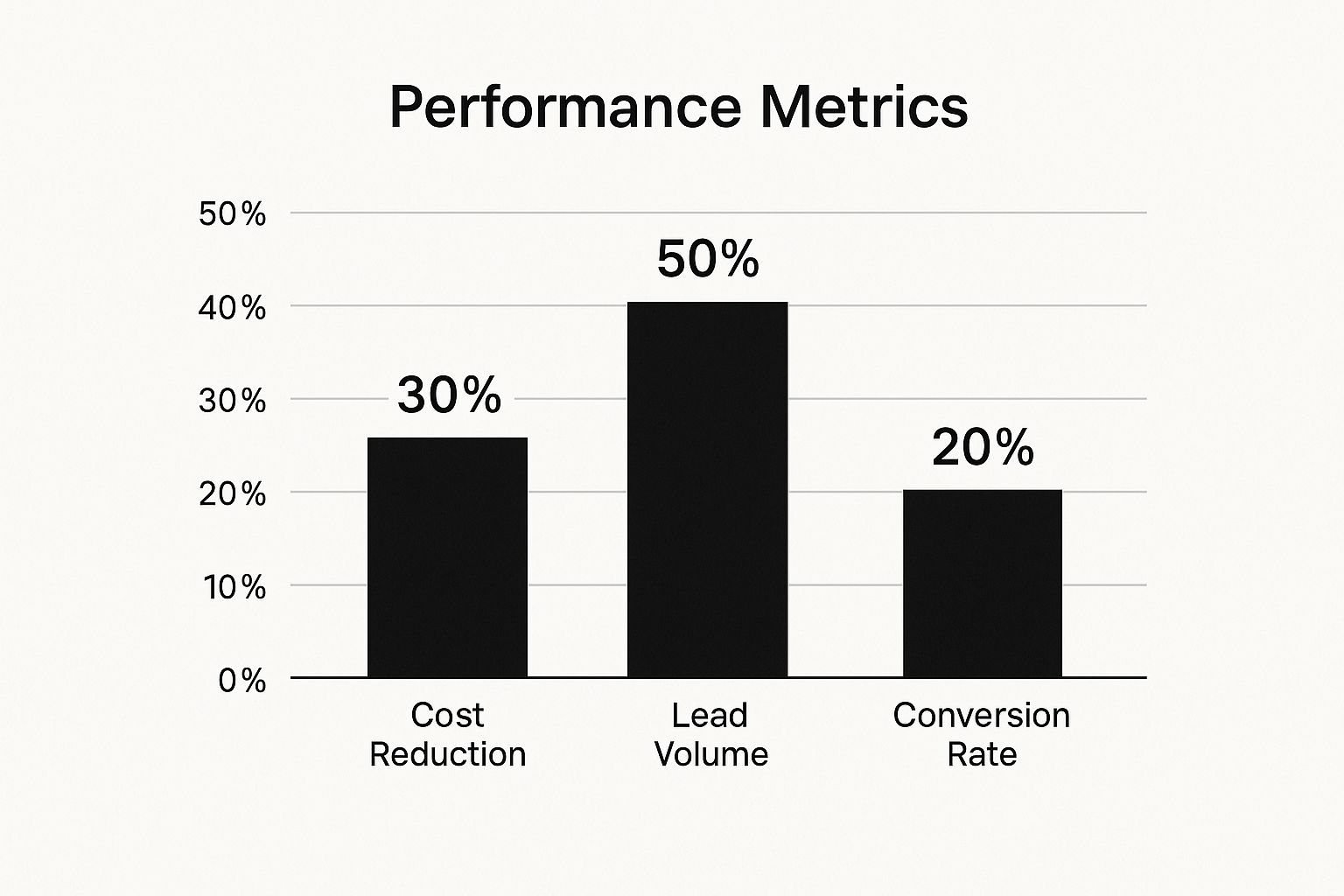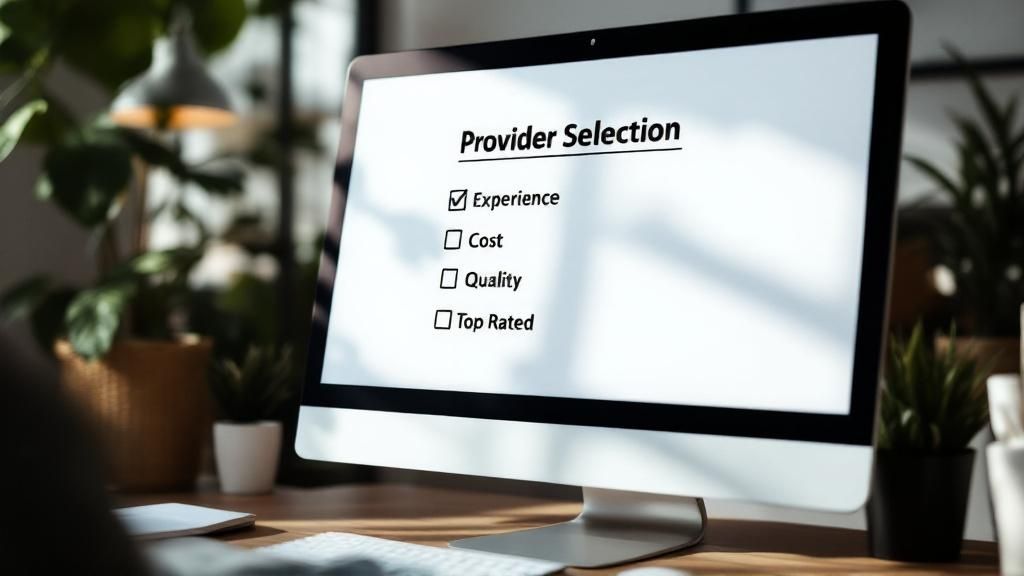Before you even think about outsourcing lead generation, you need to get your own house in order. I've seen it time and time again: companies jump into a partnership, full of excitement, only to see it fall flat. Why? Because they skipped the prep work.
This initial groundwork is what separates the wildly successful campaigns from the ones that are just a massive waste of money. It's about laying a solid foundation so your chosen partner can hit the ground running and deliver results you can actually measure.
Building Your Foundation for Outsourcing Success

Diving into an outsourced partnership without this prep is like building a house on sand. The excitement fades fast when reality doesn't match your expectations. Real success doesn't start with the first cold call an agency makes; it starts with your internal strategy and clarity.
Before you even start looking at vendors, it's a good idea to explore the best ways to generate leads yourself. This gives you a much better handle on what you should expect your partner to focus on.
Define Your Ideal Customer With Precision
You have to go way beyond basic demographics. A truly effective Ideal Customer Profile (ICP) is more than just company size and industry. It's a living, breathing portrait of the businesses that get the absolute most value from what you sell.
Start by analyzing your best customers—the ones you wish you could clone. What do they all have in common? But don't just look at who they are; dig into why they bought from you in the first place.
- Pain Points: What specific, expensive problems were they desperate to solve?
- Buying Triggers: What happened inside their company or in their market that kickstarted their search?
- Key Stakeholders: Who was actually involved in the decision? Think about everyone, from the person doing the initial research to the one who holds the purse strings.
A rock-solid ICP is the compass for your outsourced team. It ensures every bit of their effort is aimed at prospects who are genuinely likely to convert. Without it, they’re just flying blind, and that's a surefire way to burn through your budget.
Set Tangible Goals and KPIs
"We need more leads" isn't a goal. It's a wish. If you want to hold your partner accountable and see a real return on your investment, you need specific, quantifiable objectives. Vague targets will always lead to vague results.
Your goals should connect directly to your sales pipeline and, ultimately, your revenue. This shifts the entire conversation from focusing on busywork metrics (like calls made) to impact metrics (like sales-qualified opportunities).
Get your Key Performance Indicators (KPIs) nailed down before you sign a single contract. These are the numbers that truly matter. They might include:
- Number of Sales Qualified Leads (SQLs) per month: These are the leads your own sales team has vetted and given their stamp of approval.
- Cost Per SQL: A simple but powerful calculation: your total investment divided by the number of accepted leads.
- Pipeline Value Generated: The total dollar value of the sales opportunities created directly from the campaign.
Align Your Internal Teams
Honestly, the biggest bottleneck in outsourced lead generation often isn't the agency. It's a lack of alignment between the client's own sales and marketing teams.
A seamless handoff process is absolutely critical. If your sales team isn't ready and willing to jump on the leads your partner generates, the whole investment is pointless.
Make sure everyone is on the same page. Your sales reps need to understand the qualification criteria inside and out and be prepared to follow up fast. At the same time, your marketing team should be supporting the effort with relevant content and consistent messaging. This internal harmony is what turns a simple lead gen service into a true growth engine for your entire business.
Finding the Right Lead Generation Partner
This is probably the most critical decision you'll make in this whole process. Getting it right means finding a partner who feels like a true extension of your team, driving real, measurable growth. Get it wrong, and you can burn through your budget with painfully little to show for it. You have to look past the slick sales pitch and start asking the hard questions.
Let’s be honest, the financial upside is a huge reason this is so popular. Outsourcing B2B lead generation has become the go-to strategy because it's just plain faster and more cost-effective than building a sales team from scratch. We’re talking about potentially slashing costs by up to 70% when you eliminate salaries, benefits, and expensive tech stack subscriptions.
When you look at the numbers, it's pretty clear why companies are making the switch.

This data isn't just fluff; it shows the real-world impact of finding a solid partner. You see significant cost reductions right alongside major bumps in lead volume and, most importantly, conversions.
Let’s dig into the nitty-gritty of what a comparison looks like. When you stack up the costs side-by-side, the difference becomes incredibly stark. Building an in-house team involves a lot more than just a base salary.
In-House vs Outsourced SDR Team Cost Comparison
| Expense Category | In-House SDR Team (Annual Estimate) | Outsourced Agency (Annual Estimate) |
|---|---|---|
| Base Salaries (2 SDRs) | $100,000 | Included in retainer |
| Commissions & Bonuses | $40,000 | Included in retainer |
| Benefits (Health, etc.) | $20,000 | N/A |
| Recruiting & Hiring | $15,000 | N/A |
| Training & Onboarding | $10,000 | Included in retainer |
| Tech Stack (CRM, etc.) | $12,000 | Included in retainer |
| Management Overhead | $25,000 | Included in retainer |
| Total Annual Cost | $222,000 | $60,000 – $84,000 |
The table really speaks for itself. The all-in cost of an in-house team quickly balloons, while an agency provides a much more predictable, and significantly lower, expense. This is why so many businesses are looking to outsource this function.
Dig Into Their Process and Expertise
A great partner will be an open book about how they operate. If you get vague answers about their "secret sauce" or proprietary methods, that’s a massive red flag. Their process is about to become your process, so you need to know exactly what you’re signing up for.
Don't be afraid to get specific. Here’s what I’d ask:
- Data Sourcing: Where are you getting contact data? Seriously, what's the source? How often is it refreshed and verified?
- Lead Qualification: Walk me through your exact process. What specific criteria does a lead have to meet before you hand it over to my sales team?
- Tech Stack: What tools are you using for outreach? How do you manage deliverability and personalization at scale?
- Communication: How often will we talk? Will I have a dedicated person I can call? Are we doing weekly check-ins or just getting a report at the end of the month?
Their answers should give you a gut feeling of confidence. You want to hear that they have a structured, repeatable system for finding the kinds of leads that actually turn into customers.
Scrutinize Their Track Record
Case studies are nice, but they're marketing materials. You need to dig deeper. A glossy PDF is one thing, but verifiable success is what matters. Ask them for examples of campaigns they’ve run for companies like yours—same industry, similar deal size, same target audience.
A partner’s hesitation to share relevant, specific examples is a clear warning sign. Transparency is non-negotiable when you're entrusting an agency with your brand's reputation and your marketing budget.
When you're looking at their past work, focus on the outcomes. Did they just generate a big list of names, or did they produce qualified opportunities that turned into real, tangible revenue? That's the difference between a simple list-builder and a genuine growth partner.
Watch for These Red Flags
As you talk to different agencies, keep your skeptic's hat on. A little due diligence now will save you a world of headaches later.
Here are a few things that should make you pause:
- Guaranteed Results: This is a big one. No one can guarantee sales. They can forecast and set targets based on experience, but a hard guarantee is a sales tactic, not a business promise.
- Lack of Transparency: If they're cagey about their process, data sources, or even who will be working on your account, just walk away.
- One-Size-Fits-All Approach: If they aren't asking you a ton of questions about your business and your ideal customer, they’re just planning to plug you into their standard template. That rarely works.
- No Focus on Quality: An agency that brags only about the volume of leads is a recipe for disaster. Your sales team will end up swamped with junk, and morale will plummet.
Finding the right partner takes work, but it's an investment that pays for itself over and over. You want a team that shows they get your industry, is transparent about how they work, and is genuinely committed to helping you win.
You’ve vetted the agencies, scrutinized their case studies, and finally picked your partner. Great. But now the real work starts.
The launch phase is where everything you've built either comes together beautifully or starts to show cracks that can sink the whole project. Getting this first campaign off the ground correctly is absolutely critical for any long-term success.

It all has to begin with a proper kickoff meeting. This isn't just a box-ticking exercise; it’s a strategy session that sets the tone for the entire relationship. You need everyone in that room (or on that call): your marketing lead, a sales manager, the agency's account manager, and their campaign strategist.
The agenda should be laser-focused. You're there to review the Ideal Customer Profile (ICP), lock in the campaign goals and KPIs, and get on the same page about messaging. This is your moment to make sure the agency truly gets your brand voice and value prop. A message that’s even slightly off-brand can do more harm than no message at all.
Integrating Your Tech Stack
One of the most common—and frustrating—hiccups is the technology handoff. How will leads from your partner actually get to your sales team? If the plan involves spreadsheets and manual emails, you’re setting yourself up for failure. Leads will inevitably fall through the cracks and go cold.
A seamless integration between your systems is non-negotiable. For example, connecting your partner's outreach tool directly to your CRM, like Salesloop.io, creates a smooth, automated flow of information. This accomplishes two huge things:
- Speed to Lead: Your reps get an alert the second a hot lead comes in, letting them follow up while the prospect is still engaged.
- Closed-Loop Reporting: You can actually track a lead from the first touchpoint all the way to a closed deal. This is the only way to get a clear picture of your campaign ROI.
Without this technical handshake, you’re flying blind. You’ll have no idea which campaigns are pulling their weight or how much revenue your investment is really generating.
The Collaborative Approval Process
Once the tech is wired up, the focus shifts to the creative side. Your partner will start drafting the first email sequences and building out target prospect lists based on your ICP. But they shouldn't hit "send" on anything without your explicit approval.
A great partner operates on a "trust but verify" model. They bring the outreach and data expertise, but you are the ultimate expert on your customer and your brand. The approval process should be a dialogue, not a dictation.
When you get those first drafts, ask yourself these three questions:
- Does this copy sound like us? Is the tone right? Does it match your brand?
- Is this list really our ICP? Spot-check the prospect list. Do the companies and job titles feel like a perfect fit?
- Is the value prop crystal clear? Does the message directly address the pain points you know your ICP has?
This back-and-forth cycle of creation, feedback, and tweaking is what builds trust. It ensures that first wave of outreach is as sharp and effective as possible, setting the stage for a successful outsourced lead generation program.
How to Optimize Campaign Performance
Getting your first campaign live is a huge step, but honestly, it’s just the starting line. The real magic in outsourced lead generation happens after the launch. If you treat this as a "set it and forget it" deal, you're setting yourself up for disappointment. Real success comes from a constant cycle of testing, learning, and tweaking your strategy.
Your job now switches from setup to strategic oversight. Those first few weeks are a goldmine for data. You’ll immediately start seeing which subject lines are getting opened, what kind of messaging sparks a reply, and which segments of your ICP are actually engaging. This isn't just random activity; it's your market giving you direct, unfiltered feedback.
Establish a Strong Feedback Loop
Think of your agency as an extension of your team. The only way they can get better is if you talk to them. I recommend setting up weekly check-ins, at least for the first month or two, to go over the campaign data together. This isn't about blaming anyone for what's not working. It’s a collaborative deep dive to figure out how to improve.
And who has the best intel? Your sales team. They're on the front lines, talking to the leads your partner is generating. Their feedback on lead quality is the single most valuable piece of information you have.
- When a lead is good, get specific. Don't just say "great lead!" Tell the agency why. Was it the perfect company size? The right job title? Did they mention a specific pain point that your team could immediately address?
- When a lead is bad, be constructive. If a lead was a miss, explain exactly why. Was it the wrong industry? A person with zero buying authority? A company that was way too small to ever use your product?
This constant flow of information allows your agency to sharpen their targeting and messaging. Before long, they’ll be sending more of the leads your sales team gets excited about and far fewer of the ones that waste their time.
Apply Smarter Strategies
Once your campaign has been running for a bit, you can start getting more sophisticated than just broad outreach. This is where you can really start to see a major return on your investment.
The goal of outsourced lead gen isn't just to get more leads; it's to get the right leads. You have to move from casting a wide net to throwing a sharp spear, hitting high-value accounts with personalized outreach that actually gets their attention.
A fantastic way to do this is to bring in Account-Based Marketing (ABM) principles. Work with your agency to create a shortlist of "whale" accounts—those high-value dream clients. From there, the agency can develop hyper-personalized campaigns just for them. It’s a game-changer for landing bigger deals. Thinking about how to automate lead generation in this context can free up your agency to spend more time on that high-touch personalization.
The numbers don't lie. Marketers who integrate strategies like ABM into their outreach report an 87% higher ROI. And it gets better. By using multiple channels—like email, LinkedIn, and calls—you can boost response rates by as much as 40% while simultaneously lowering your cost per lead.
Measuring Real ROI and Scaling Your Program

So, is your outsourced lead gen experiment actually paying off? To figure that out, you have to look past the flashy, feel-good numbers. High open rates and click-throughs are nice, but they don't put money in the bank. Real success is measured by the metrics that directly impact your bottom line.
Let's be honest, the whole point of bringing in a partner is to drive real growth, not just to generate "activity." This means you need a disciplined way to track performance and understand the true financial impact of your campaigns.
Focus on Metrics That Matter
To get a clear picture of your program’s health, you need to follow the leads all the way through your sales funnel. This isn't just about what happens in the agency's outreach system; it’s about what happens inside your own sales process.
Forget the vanity metrics for a second and zero in on these three critical numbers:
- Cost Per Lead (CPL): This is your starting point. Just take your total monthly spend and divide it by the number of leads you got. It tells you the raw cost of getting a name on your list.
- Cost Per Opportunity (CPO): Now we're getting somewhere. This is the cost to create a legitimate, sales-accepted opportunity in your pipeline. It filters out the noise and shows what you’re really paying for a solid sales conversation.
- Customer Acquisition Cost (CAC): This is the holy grail. It’s the total program cost divided by the number of deals you actually closed from those leads. It directly answers the question, "How much did it cost us to land this new customer?"
When you track these figures, you can have real, data-driven conversations with your partner about what’s working and what’s not. Pinpointing the true cost of acquiring a customer through this channel is what allows you to make smart decisions about your budget.
A successful outsourced program isn't just another lead source; it's a predictable revenue engine. The goal is to get to a place where you can confidently say, "For every dollar we put in, we get five dollars back in new business."
Know When It's Time to Scale
Once you’ve got a handle on your metrics and see a consistent, positive return, it’s time to hit the accelerator. Scaling your outsourced lead generation program isn't just about throwing more money at it; it's a strategic move to fast-track growth.
You'll know it's time to scale when a few things line up:
- Your CAC is healthy and predictable: You have a clear, profitable model for winning new customers.
- Your sales team can handle more: They have the bandwidth to manage a higher volume of quality leads without dropping the ball.
- Your partner is crushing it: The agency consistently delivers high-quality leads that your sales team is excited to work with.
This is a smart investment, and it reflects a much broader market shift. The global lead generation market is projected to hit USD 6.38 billion by 2025, expanding at a CAGR of 8.3%. Why? Because digital-first strategies are no longer optional for growth.
Scaling might mean boosting your budget to go after more prospects in your current sweet spot. Or, it could mean expanding into new industries or regions. By exploring a wider range of B2B lead generation strategies, you can work with your partner to find new pockets of opportunity and build on the success you've already created.
Got Questions About Outsourcing Lead Generation?
Even when you've got a solid plan, handing over a piece of your sales process to a third party can feel like a leap of faith. It's totally normal to have questions. Getting them answered upfront is key to building confidence and making sure everyone, from leadership down to the sales team, is on the same page.
Let's walk through some of the most common concerns we hear from businesses just like yours.
How Long Until We Actually See Results?
This is usually the first thing people ask, and for good reason. You're making an investment, and you want to know when it will pay off.
While you'll probably see some initial buzz—opens, clicks, and a few replies—within the first month, it's crucial to set the right expectations. I always tell clients to think of the first 90 days as a "calibration phase." This isn't just filler time; it's when the real work happens.
During this period, your partner is in the trenches, testing messages, tweaking prospect lists, and figuring out what truly clicks with your ideal buyers. A steady, predictable stream of high-quality leads that makes a real dent in your sales pipeline? That typically takes three to six months to build.
Any good partner will be straight with you about this. They're focused on building a sustainable engine for growth, not promising you a magic button for instant leads.
Be very skeptical of any agency that promises to flood your calendar with sales-ready appointments in the first 30 days. Real B2B success is a marathon built on data and refinement, not a sprint.
How Do I Know My Brand Will Be Represented Well?
This is a big one. You've spent years building your brand's reputation, and the idea of someone else speaking on your behalf can be nerve-wracking. A reputable partner gets this. Protecting your brand isn't just a line item; it's a non-negotiable part of the deal.
They should operate like a natural extension of your own team. Here’s what that looks like in practice:
- You're Always in Control of the Message: You get the final say on all email copy, subject lines, and any scripts before a single one is sent. No surprises.
- They Learn Your Voice: A good partner will take the time to understand your company's tone. Are you formal and corporate, or casual and conversational? They'll adapt to match.
- They Look Like Part of Your Team: Most of the time, they'll use email aliases from your own domain (like
sdr.name@yourcompany.com) to maintain a professional and unified front.
Your contract should spell out brand representation and confidentiality clearly. But beyond that, regular check-in calls are vital to keep everything aligned and ensure your brand's voice stays consistent.
What Are the Biggest Mistakes We Should Avoid?
Knowing the common traps is half the battle. So many businesses stumble over the same hurdles when they start outsourcing.
By far, the most damaging mistake is having a fuzzy Ideal Customer Profile (ICP). If you don't know exactly who you're targeting, you'll waste a ton of time and money talking to the wrong people. Another classic error is picking a partner based on price alone. The cheapest option almost always leads to low-quality leads and a frustrating experience.
A "set it and forget it" mindset is another killer. This isn't a crockpot; it's a collaboration. Your active feedback is what makes a campaign successful. And finally, a surprisingly common failure is not having a clear plan for what to do with the leads once you get them. Good leads will go cold fast if your team isn't ready to act.
Ready to skip the common mistakes and build a scalable outreach program with a team of experts? Salesloop.io offers a fully managed service where we handle everything from strategy and list-building to campaign optimization, booking meetings directly onto your calendar. Learn more at https://salesloop.io.





